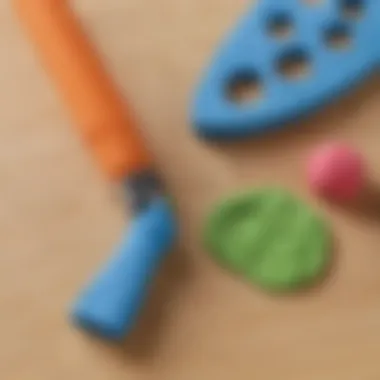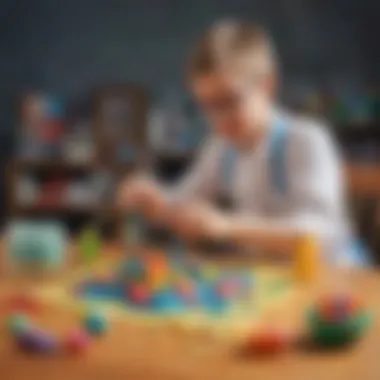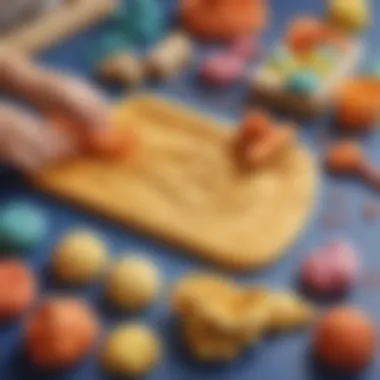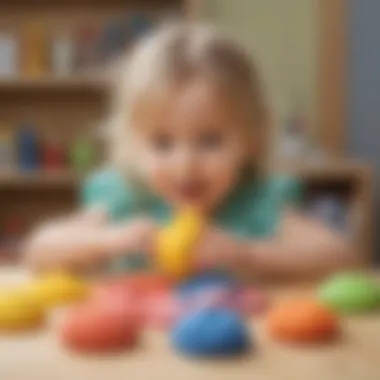Unlocking the World of Play Dough: Engaging Science Activities for Curious Minds


Science Fun Facts
Play dough isn't just a squishy substance for molding; it can also serve as a fun tool for learning basic scientific principles. Did you know that by mixing different colors of play dough, you can demonstrate the concept of color mixing similar to how primary colors combine to create new hues? This simple yet effective activity can spark curiosity and lay the foundation for more complex scientific explorations.
Discover the Wonders of Science
Exploring Various Scientific Concepts
Engage young science enthusiasts in hands-on experiments using play dough to delve into concepts like buoyancy, conductivity, and chemical reactions. By shaping play dough into boats and testing their ability to float, children can grasp the idea of buoyancy in a playful manner.
Educational Videos and Animations
Pairing interactive play dough activities with educational videos can further enhance the learning experience. Visual aids can help children visualize abstract scientific concepts, making learning more accessible and engaging.
Interactive Learning Tools
Utilize resources like online simulations and interactive tools to supplement play dough experiments. These tools can provide virtual hands-on experiences and promote active participation in the learning process.
Real-Life Applications of Science
Connect play dough activities to real-world applications of scientific principles to demonstrate the relevance of STEM concepts in everyday life. For example, molding play dough circuits can introduce children to the basics of electrical conductivity.
Science Quiz Time
Interactive Quizzes
Challenge young learners with interactive quizzes related to the scientific concepts explored through play dough activities. Quizzes can reinforce understanding and encourage retention of key information.
Multiple Choice Questions
Present multiple choice questions that test children's knowledge of various scientific phenomena, incorporating play dough-related scenarios to make the quiz more engaging and relatable.
Brain Teasers and Puzzles
Integrate brain teasers and puzzles into science quizzes to stimulate critical thinking and problem-solving skills. These activities can add an element of fun and challenge to the learning process.
Learning Through Gamification
Gamify the learning experience by awarding points or prizes for correct quiz answers, creating a sense of achievement and motivation among young science enthusiasts.
Science Experiment Showcase
Fun and Engaging Experiments


Explore a range of fun and engaging experiments that use play dough as a versatile medium for hands-on science demonstrations. From creating volcanoes that erupt with baking soda and vinegar to building simple machines with play dough components, the possibilities for experimentation are endless.
Step-by-Step Instructions
Provide clear and detailed instructions for each science experiment, ensuring that children can follow along easily and safely. Step-by-step guidance promotes independence and empowers young learners to conduct experiments with confidence.
Materials List
List all the necessary materials and tools required for each experiment to facilitate preparation and organization. By gathering the supplies in advance, children can focus on the scientific process without interruption.
Safety Tips and Precautions
Prioritize safety by including precautionary measures and guidelines for conducting experiments with play dough. Emphasize the importance of adult supervision, proper handling of materials, and adherence to safety protocols to ensure a secure and enjoyable learning environment.
Introduction to Play Dough Activities
Play dough activities hold a remarkable place in the realm of childhood education. The tactile nature of play dough appeals to young minds, enhancing their sensory experiences and fine motor skills. Through the manipulation of this pliable substance, children can delve into a world of creativity and exploration. This article focuses on unveiling the significance of play dough activities, emphasizing their role in fostering creativity, sensory awareness, and scientific understanding among young enthusiasts.
Benefits of Play Dough for Children
Enhancing Fine Motor Skills
Enhancing Fine Motor Skills through play dough activities involves the intricate movements required to knead, pinch, shape, and mold the dough. This process aids in refining hand-eye coordination and dexterity in children. The repetitive actions of rolling and cutting play dough contribute to strength and precision in their hand muscles, essential for tasks like writing and drawing.
Boosting Creativity and Imagination
Play dough serves as a versatile medium for children to unleash their creativity and imagination. By sculpting various shapes, creatures, and structures, young minds can transcend conventional boundaries and explore limitless possibilities. The open-ended nature of play dough encourages children to experiment, innovate, and express their unique ideas through hands-on manipulation.
Developing Sensory Awareness
Engaging with play dough stimulates multiple senses, heightening sensory awareness in children. The pliable texture, vibrant colors, and varied scents of the dough offer a sensory-rich experience. Children develop tactile sensitivity, visual perception, and olfactory discernment as they immerse themselves in sensory exploration while playing with dough.
Educational Value of Play Dough
Exploring Shapes and Colors
Exploring Shapes and Colors using play dough introduces children to fundamental concepts in geometry and visual aesthetics. By shaping dough into different forms and mixing colors, children learn about spatial relationships, symmetry, and color theory. This hands-on approach to learning enhances their artistic appreciation and cognitive understanding of shapes and hues.
Introducing Basic Science Concepts
Introducing Basic Science Concepts through play dough activities ignites children's curiosity and understanding of scientific principles. By experimenting with phenomena like buoyancy, conductivity, and chemical reactions using play dough, children grasp basic scientific concepts in a tangible and interactive manner. This hands-on experimentation cultivates a foundation for further scientific exploration.
Fostering Problem-Solving Skills
Fostering Problem-Solving Skills with play dough challenges children to think critically, innovate solutions, and overcome obstacles. When confronted with design dilemmas or construction tasks, children engage in creative problem-solving strategies. This process hones their analytical thinking, spatial reasoning, and perseverance, fostering a growth mindset towards tackling challenges.


Creative Play Dough Activities
Creative Play Dough Activities play a pivotal role in the holistic development of children aged 6-12, encompassing a myriad of essential skills and fostering creativity, innovation, and critical thinking. In this article, the significance of Creative Play Dough Activities lies in providing a hands-on platform for young minds to explore and experiment, encouraging them to think outside the box while honing their fine motor skills, spatial awareness, and problem-solving abilities. By engaging in Creative Play Dough Activities, children not only unleash their artistic flair but also immerse themselves in a world where imagination knows no bounds.
Sensory Exploration with Play Dough
Texture Mixing Experiment
Through the invigorating Texture Mixing Experiment, children delve into a tactile journey that stimulates their senses and enhances their cognitive development. This experiment allows young learners to experience different textures, understand material properties, and unleash their creativity through the amalgamation of various play dough textures. The key characteristic of Texture Mixing Experiment lies in its ability to engage multiple senses simultaneously, offering a holistic sensory experience that fosters cognitive connections and enhances sensory awareness. While Texture Mixing Experiment is a popular choice for this article due to its versatility and hands-on nature, it also promotes exploration and curiosity, igniting a sense of wonder in young science enthusiasts.
Scented Play Dough Creations
By delving into the realm of Scented Play Dough Creations, children embark on a fragrant adventure that not only ignites their olfactory senses but also sparks creativity and imagination. The unique feature of Scented Play Dough Creations lies in the integration of scents, enhancing the sensory experience and adding a new dimension to traditional play dough activities. While offering a multisensory experience, Scented Play Dough Creations provide children with a delightful platform to experiment with various scents, understand aromas, and engage in sensory exploration that transcends traditional boundaries.
Sound Sculptures
In the realm of artistic expression, Sound Sculptures offer a unique avenue for children to explore the fusion of art and auditory elements. Sound Sculptures enable young creators to experiment with shapes, structures, and sound dynamics, merging the visual and auditory domains into a seamless artistic experience. The key characteristic of Sound Sculptures lies in their interactive nature, allowing children to not only visualize their creations but also engage in auditory exploration, making art come alive through sound. While Sound Sculptures add a layer of complexity to traditional play dough activities, they present an engaging and innovative way for young science enthusiasts to express themselves artistically.
Artistic Creations with Play Dough
Play Dough Sculptures
Play Dough Sculptures serve as a tangible medium for children to mold, shape, and design their imaginative creations, honing their artistic skills and spatial reasoning. The key characteristic of Play Dough Sculptures lies in their versatility, providing children with a blank canvas to bring their ideas to life through three-dimensional forms. While Play Dough Sculptures offer a hands-on approach to artistic expression, they also encourage children to think critically, plan their designs, and execute them with precision, fostering a sense of accomplishment and creative satisfaction.
Stamping and Printing Techniques
By exploring Stamping and Printing Techniques with play dough, children venture into the realm of visual arts, experimenting with patterns, textures, and design elements. The unique feature of Stamping and Printing Techniques lies in their ability to create detailed imprints, intricate patterns, and artistic textures using simple tools and techniques. While Stamping and Printing Techniques enhance children's fine motor skills and creativity, they also provide a platform for self-expression, enabling young artists to showcase their unique perspectives through personalized artworks.
3D Modeling Projects
Dive into the world of 3D Modeling Projects, where young minds explore spatial reasoning, geometry, and design concepts through the creation of three-dimensional structures. The key characteristic of 3D Modeling Projects lies in their capacity to transcend traditional flat artwork, inspiring children to think in multiple dimensions and visualize their ideas in a tangible form. While 3D Modeling Projects offer a hands-on approach to geometry and design, they also cultivate innovation, problem-solving skills, and attention to detail, empowering young science enthusiasts to bring their vision to life in a three-dimensional space.
Science-Inspired Play Dough Activities
In this article, the focus shifts towards Science-Inspired Play Dough Activities, offering a unique blend of entertainment and education. Engaging young minds with hands-on experiments, these activities provide a gateway to understanding basic scientific principles in a stimulating manner. By incorporating elements of science into playtime, children not only have fun but also develop a curiosity for the world around them. The seamless integration of science concepts within play dough sessions makes learning a dynamic and enjoyable experience.
Exploring Basic Science Concepts
Sink or Float Experiment
The Sink or Float Experiment introduces children to the fundamental concept of density and buoyancy through playful experimentation. By testing various objects' behavior in water, kids observe firsthand how some items sink while others float based on their weight and shape. This experiment not only sparks curiosity but also encourages critical thinking as children make predictions and analyze outcomes. It is a popular choice for this article due to its hands-on nature and ability to teach children about scientific principles in a simple yet effective manner.
Simple Circuit Creations


Simple Circuit Creations delve into the world of electricity and circuits, allowing young learners to explore the basics of conductors and insulators. By constructing simple circuits using play dough as a conductor, children gain insight into how electricity flows and completes a circuit. This hands-on activity not only demonstrates scientific concepts but also nurtures problem-solving skills as kids troubleshoot to ensure their circuits work efficiently. The unique feature of this activity lies in its ability to make abstract concepts tangible, offering a practical foundation in electrical engineering.
Volcano Eruptions
Volcano Eruptions bring the thrill of geological processes to the play dough table, enabling children to create their mini volcanic eruptions. By mixing baking soda, vinegar, and red food coloring within a play dough volcano structure, kids witness a chemical reaction that mimics a volcanic explosion. This activity not only ignites imagination but also introduces kids to simple chemical reactions in a visually captivating manner. The advantage of this experiment in this article is its ability to combine fun and education seamlessly, leaving a lasting impression on young science enthusiasts.
Mathematical Adventures with Play Dough
Shape Sorting and Patterns
Shape Sorting and Patterns engage children in exploring geometric shapes and patterns using play dough as a versatile medium. Through hands-on manipulation of dough, kids develop spatial awareness, shape recognition, and pattern creation skills. This activity is a popular choice for the article due to its ability to merge art and mathematics, fostering creativity and logical thinking simultaneously.
Counting and Measurement Activities
Counting and Measurement Activities provide children with a sensory-rich environment to practice counting, length measurement, and volume estimation. By incorporating numerical concepts into play dough play, kids enhance their mathematical abilities while having fun. This activity's unique feature lies in its adaptability to different skill levels, allowing children to progress from basic counting to more complex measurement tasks.
Fraction Fun with Play Dough
Fraction Fun with Play Dough introduces children to the concept of fractions through hands-on manipulation of dough portions. By dividing and combining dough balls into equal parts, kids grasp the idea of fractions as parts of a whole. This activity not only simplifies a challenging math concept but also reinforces the relationship between parts and the whole. The advantage of this activity in the article is its interactive approach to teaching fractions, making abstract math tangible and accessible to young learners.
Interactive Play Dough Challenges
In the realm of play dough activities for young science enthusiasts, the Interactive Play Dough Challenges stand as pillars of not just entertainment but also cognitive development. These challenges not only foster creativity but also enhance teamwork and problem-solving skills. Engaging in hands-on tasks like play dough challenges offers children a dynamic and interactive way to learn, stimulating their minds and encouraging exploration. By immersing in these activities, young learners can develop crucial skills while having fun.
Team Building Activities
Play Dough Tower Challenge
The Play Dough Tower Challenge represents a unique amalgamation of creativity and structural engineering. This challenge prompts children to construct towers using play dough, pushing the boundaries of their imagination and dexterity. By encouraging them to strategize and experiment with different designs, the Play Dough Tower Challenge offers a hands-on experience in problem-solving and spatial reasoning. This activity not only promotes teamwork but also enhances fine motor skills and critical thinking. Participants learn the significance of balance, stability, and design aesthetics, instilling valuable lessons in a playful setting.
Collaborative Sculpting Projects
Collaborative Sculpting Projects embody the essence of teamwork and shared creativity. In this activity, children collaborate to create intricate sculptures using play dough, fostering cooperation, communication, and creative expression. By working together towards a common artistic goal, participants learn the importance of coordination, compromise, and collective decision-making. Collaborative sculpting nurtures a sense of unity and belonging, encouraging children to appreciate diverse perspectives and contribute to a collective masterpiece.
Obstacle Course Creations
Obstacle Course Creations offer a dynamic and challenging platform for young learners to engage with play dough actively. By designing obstacle courses and navigating them using play dough creations, children develop problem-solving skills, spatial awareness, and perseverance. This activity not only ignites imagination but also promotes physical activity and strategic planning. Participants face obstacles that require innovative solutions, enhancing their adaptability and resilience. Obstacle Course Creations provide an exciting blend of creativity and obstacle-solving, making learning a thrilling adventure.
Problem-Solving Missions
Escape Room Adventures
Step into the realm of Escape Room Adventures, where young minds are put to the ultimate test of wit and ingenuity. This activity challenges participants to solve puzzles and unlock mysteries using play dough clues, fostering critical thinking and analytical skills. By deciphering codes, unraveling enigmas, and collaborating with peers, children hone their problem-solving abilities and attention to detail. Escape Room Adventures offer an immersive and engaging way to enhance logic, deduction, and mental agility, transforming learning into an exhilarating quest for solutions.
Mystery Object Creations
Mystery Object Creations introduce an element of intrigue and discovery into play dough activities. Participants are tasked with molding play dough into objects shrouded in mystery, encouraging imagination, deduction, and storytelling. By shaping ambiguous forms and unraveling the identities of their creations, children exercise their creativity, logic, and cognitive flexibility. Mystery Object Creations inspire curiosity and investigation, prompting participants to think outside the box and craft narratives around their enigmatic sculptures.
Reverse Engineering Challenges
Reverse Engineering Challenges provide a fascinating twist to traditional play dough activities, prompting children to deconstruct and recreate complex structures. By reverse-engineering intricate designs using play dough, participants gain insight into mechanisms, patterns, and problem-solving methodologies. This activity encourages analytical thinking, spatial reasoning, and experimentation, challenging children to interpret and reconstruct objects from unconventional perspectives. Reverse Engineering Challenges offer a stimulating and intellectually rewarding experience, fostering a deeper understanding of form, function, and creativity.







